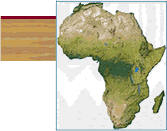HIV/AIDS IN AFRICA
More than 90 percent of adults infected with HIV live in developing
countries.
Two-thirds of the total number of people in the world living with HIV are
in Sub-Saharan
Africa. While Central and Western Africa remain the hardest hit by
HIV/AIDS, Sub-Saharan
Africa is the region in which the epidemic is growing fastest. Nearly all
(over 97
percent) of infected Africans do not know they are infected, mainly
because they lack
awareness of or access to HIV testing. Contrary to conventional wisdom,
heterosexual
transmission accounts for most infections and at least 43 percent of all
infected adults
in developing countries are women.
The consequences of this epidemic are far-reaching. As AIDS mortality
rises, a growing
number of children will be orphaned. This will exacerbate poverty and
inequality. By the
year 2010, AIDS will have made orphans of almost 40 million children in
Sub-Saharan
Africa. Very young orphans whose mothers are infected or die of AIDS have
higher mortality
rates than other orphans because roughly one-third of them are themselves
infected with
HIV at or around the time of birth. Also, AIDS orphans are more likely to
become
two-parent orphans because HIV is transmitted sexually.
In Sub-Saharan Africa, 7.4 percent of all those aged 15-49 are
believed to be infected
with HIV (this contrasts with 0.5 percent of adults infected in the
United States). The
potential for political and economic instability is tremendous. Only a
small number of
individuals with HIV-related disease can afford effective new drug
regimens and most will
die within 5-7 years of becoming infected. Further, HIV/AIDS causes
illness and death
among adults in the most productive age groups, resulting in
significantly slower growth
of the labor force and heightening educational needs among a population
which is losing
the well-educated as well as the under-educated. Most Sub-Saharan African
countries face
the dual challenge of lowering HIV prevalence and of coping with the
impact of existing
high prevalence on their health systems and societies.
Early government commitment and intervention can slow the spread of
AIDS decisively.
While incidence is still high, recent trend data in Uganda show that
government efforts
can be extremely effective. In 1997, 5-9 percent of Ugandan adults were
infected, compared
to 7-12 percent in 1996. This decrease is most pronounced among Ugandan
youth, concurring
with studies which have shown that they are adopting safer sexual
behavior (including
later sexual initiation, fewer partners and increased condom use).
To combat and contain the spread of HIV/AIDS, there remains continued
need for
heightened public awareness and government intervention. The U.S.
Government has focused
its efforts on prevention of heterosexual transmission of HIV in
approximately 30
countries via programs that: change risky behavior through education,
motivation and
innovation; promote condom use; reduce sexually transmitted infections
that increase the
risk for HIV; improve the policy environment to reduce the transmission
of HIV; conduct
research to improve program cost-effectiveness; and increase commitment
through advocacy,
voluntary counseling and testing programs.
![]()


![[White House icon]](/New/images/home_pin.gif)
![[Help Desk icon]](/New/images/help_pin.gif)